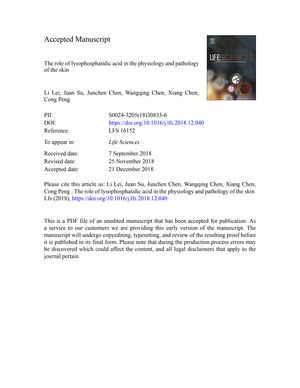The Role of Lysophosphatidic Acid in the Physiology and Pathology of the Skin
December 2018
in “
Life sciences
”

TLDR Lysophosphatidic acid is important for skin health and disease, and could be a target for new skin disorder treatments.
The document from 2019 discusses lysophosphatidic acid (LPA), the simplest phospholipid, and its role in skin physiology and pathology. LPA is synthesized by autotoxin and PA-PLA1α/PA-PLA1β and broken down by lipid phosphate phosphatases (LPPs). It functions as an extracellular signal transmitter and intracellular second messenger, interacting with both Edg family and non-Edg family LPA receptors to mediate a variety of processes including embryonic development, angiogenesis, tumor progression, fibrogenesis, wound healing, and inflammatory reactions through signaling pathways like MAPK, PI3K/Akt, PKC-GSK3β-β-catenin, Rho, Stat, and HIF-1α. In the skin, LPA is crucial for hair follicle development, wound healing, pruritus, skin tumors, and scleroderma. The review suggests that targeting LPA synthesis or its receptors could be a novel therapeutic approach for treating skin disorders.



